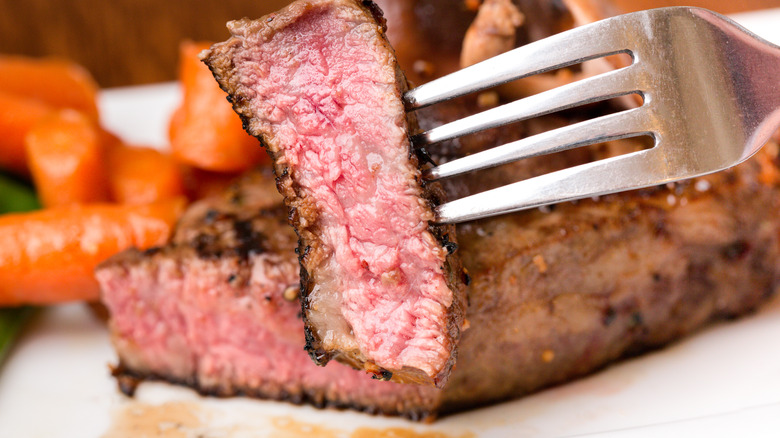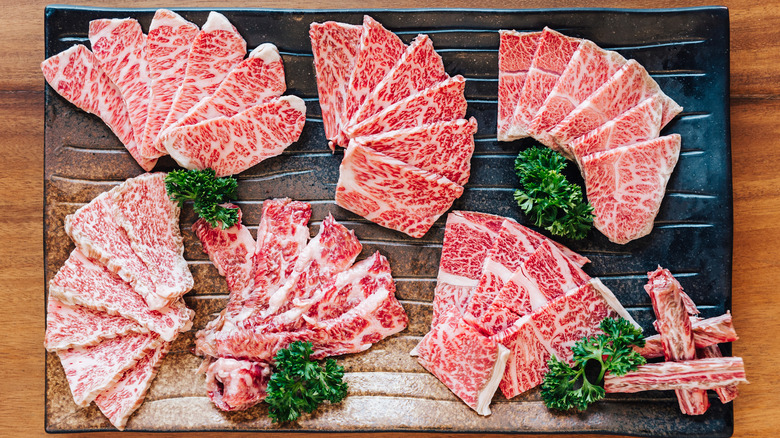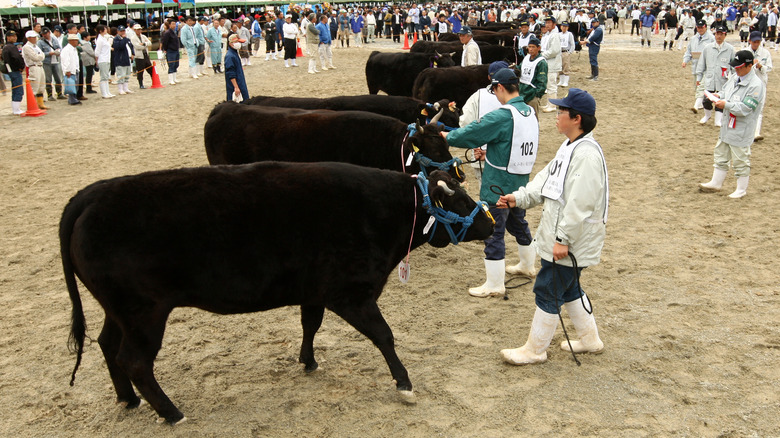What Makes Kobe Steak The Most Expensive Cut
Grocery prices ebb and flow, soaring during times of inflation or supply shortages. One renowned and coveted food item, though, remains relatively unchanged by external market fluctuations. That's because it maintains a completely separate set of criteria dictating quality, price, and availability. It's expensive, it's exclusive, and it's worth every penny (or yen, in its home country). That would be Kobe beef from Japan, considered the priciest beef on the planet and the most expensive cut of steak a person can buy — if they can get their hands on any.
Kobe steaks come from carefully reared Tajima cows, which are a particular strain of the Japanese Black breed of cattle raised in Hyogo prefecture. Named for Kobe, the capital city of Hyogo, this beef is one of the most prized carnivorous delicacies in the world, leading to unfathomable prices starting at $300 per pound in Japan or a stunning $50 per ounce in America.
Reasons for the exceptional prices are numerous, but it essentially comes down to the remarkable amount of marbling in the beef. Higher marbling in steaks results in intensely rich, juicy flavor and melt-in-your-mouth tenderness. In fact, marbled intramuscular fat in beef actually melts as it's cooked, creating its own slow marination that's unlike any you could brush on or inject externally. This high marbling comes at an accordingly high price, as do all the other attributes of Kobe steaks. The high standards required are exacting, to say the least.
Kobe raises the bar for beef perfection
The exclusive nature of Kobe beef starts with how cattle companies raise the Tajima cows, inevitably affecting the market price. The practice reportedly harkens back at least 1,000 years, when vast amounts of land allowed free roaming in nature, with ideal climates and effectively unlimited amounts of healthy mountain grass, herbs, and pristine drinking waters.
The area is still maintained as an optimal environment for any cow bearing the name Kobe. The cows must be born, fed, slaughtered, and processed on a farm within Japan's Hyogo prefecture, and the meat produced from a single cow requires a maximum weight of 1,036 pounds. Beef undergoes ratings by the Japan Meat Grading Association, testing for marbling, texture, brightness, and color of the meat and fat. On a strict scale of one to five, a Kobe beef designation requires at least a four or five. Then there's the all-important Beef Marbling Score (BMS) with a range of one to 12. Kobe steak needs a score of six or higher. Finally, there's a branding system for proof of designation, marking the beef with a Japanese Chrysanthemum emblem.
Understandably, these strict standards and associated costs limit the amount of Kobe beef that goes to market — with only an estimated 3,000 to 5,000 Tajima cattle making the cut every year. Little of that beef ever reaches U.S. shores, giving rise to less-expensive "Kobe-Style" beef or crossbred versions, typically known as American Kobe, Australian Kobe, and similar in other countries.
The price and quality difference in Kobe and wagyu beef
The terms wagyu and Kobe beef often get lumped together as one and the same but, while both are premium Japanese meats, there's an important distinction. Several types of beef in Japan can be called wagyu, since the word itself simply means Japanese beef or Japanese cow. The trademarked Wagyu designation requires that the beef comes from one of four Japanese breeds of cow: Japanese Black, Brown, Shorthorn, or Polled.
Wagyu beef can come from full-blooded, purebred, and crossbred cattle, and there are fewer restrictions on where the cattle get raised. Though still considered superior beef, the price of wagyu can be less than a third that of Kobe.
That said, Kobe beef, coming from purebred Japanese Black cows, is still a subsection of wagyu beef. It's just very rare, carefully controlled to exacting standards, and costs a whole lot more. So, if you ever have the prized pleasure of eating an actual Kobe steak from Japan, the most expensive cut in the world, just loosen your belt, open your wallet, and count it as an exquisite meal to remember.



